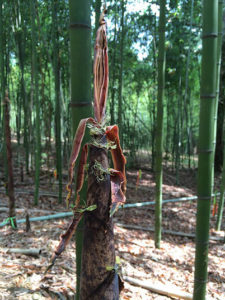JAPANESE TIMBER
Phyllostachys bambusoides
madake in Japanese
Max Ht Usual Ht Mx diam Us diam. Min Temp
72′ 50′ 6″ 2-3″ 5F
USDA ZONES 7 & 8
Ph. bambusoides is less hardy than henon and moso. It needs summer heat to get large. It produced well for Dr. D.G. Sturkie in Alabama. He notes that along with Ph. meyeri and Ph. aurea, it was damaged severely three years in the twenty they were observed. (“Bamboo Growing in Alabama”, Agricultural Experiment Station, Auburn University, Auburn Alabama, 1968.) Researchers at Savannah, Georgia, noted that P. bambusoides produced better after a cold winter. P. bambusoidesneeds some cold in winter to perform well, but of course not too low a temperature. Savannah is in coastal Georgia which is less cold in winter than middle Georgia and Alabama.
IDENTIFICATION
Culm leaf outer surfaces are completely smooth, i.e. free of hairs. The new culms are a shiny green. Striking.
Richard Haubrich writes in “Journal of the American Bambo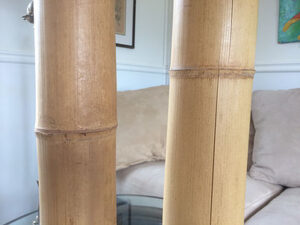 o Society”, Nov,1980:
o Society”, Nov,1980:
“Culms to 72 ft. tall and 5 3/4 in. in diameter, erect or nearly so, relatively straight; internodes up to 17 in. long on a culm 48 ft. long, green, hairless, without white powder at sheath fall, usually not ribbed; nodal rides about as prominent as the sheath scars; sheath scars thin, hairless, not strongly flared.
Culm leaf sheaths greenish to ruddy buff, densely spotted with dark brown; auricles usually developed at nodes above the basal ones, with greenish crinkled oral setae; ligules moderately well developed, the apex convex and fringed with minute hairs on smaller culms, the apex nearly straight and fringed with coarse bristles on larger ones; blades short, lance-shaped, bent back and crinkled in lower sheaths to long, strap-shaped and curved back in upper ones, green down the middle, with an equally wide band of blended wine, green, and buff on each side, and a narrow margin of cream.
Foliage leaves usually with auricles and oral setae well developed; ligules well developed; blades up to 7 1/2 by 1 1/4 in. commonly from 1 5/8 by 1/2 to 6 7/8 by 1 in.”
Ph. bambusoides is a late shooter. My research plot has begun shooting at soil temperatures from 63 to 65 degrees Fahrenheit and from mid-April until the first week in May.
The new culm is green, smooth, and does NOT have a white powdery (pruinose) ring at the node. White rings develop with age at three months or more. Culms are erect, although, at grove margins, they lean toward the light. 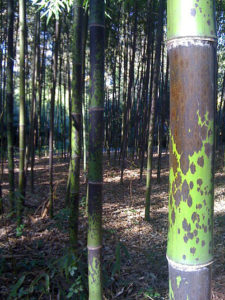
Foliage leaves are large and variable and often slightly wavy. The two branches at each branch-bearing node are unequal. The smaller arises from the base of the larger. While branch inequality is typical of the genus, it is more pronounced in Ph. bambusoides.
KNOWN FOR
Japanese timber is known for its high quality, large poles. It is the second most important bamboo in Japan.
“In Japan, it is cultivated in Kyushu, Shikoku and middle and south part of Honshu widely and it contributes to greening and bank maintenance. [ie., beauty, carbon sequestration, erosion control- D.Lewis] In spit (sic.) of bamboo material, culms are hard, fibers long and nodes soft, cleavability is high and therefore, it is well utilized as handicraft material. The sheath is hairless, resilient and long and so well utilized for wrapping. The baren, used in Japanese woodprinting, does not require any other material than this sheath.” (“The Bamboo Species in Japan”. Okamura and Tanaka 1986 p. 12)
Introduced in the 1880’s and thereafter numerous times by the USDA: P.I. numbers 12180, 77003, 118926, 128787. Because Japanese timber flowered in the 1970’s, possibly none or few of these introductions survive. What is growing now could be these clones/introductions that revegetated and/or could be their seedlings.
“The typical form of this species is the one most cultivated in China and Japan for its useful culms, and, indeed, it may be said to be the most versatile bamboo of the genus Phyllo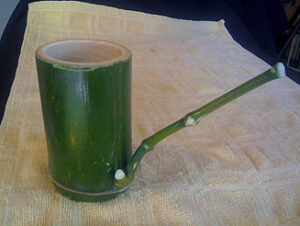 stachys. Because of this versatility, the large size reached by the culms under favorable conditions, and the prolific production of edible shoots having only a slight degree of acridity even in the raw state …, P. bambusoides has been favoured by the United States Department of Agriculture and by farmers as the one most likely to make a place for itself in the rural economy. Its only serious competitor in both size and vigor is P. vivax, whose culms are not so straight and for this reason less generally useful. (“BAMBOOS of the Genus Phyllostachys”, Agriculture Handbook No. 114, F.A. McClure, 1957, p .22-23
stachys. Because of this versatility, the large size reached by the culms under favorable conditions, and the prolific production of edible shoots having only a slight degree of acridity even in the raw state …, P. bambusoides has been favoured by the United States Department of Agriculture and by farmers as the one most likely to make a place for itself in the rural economy. Its only serious competitor in both size and vigor is P. vivax, whose culms are not so straight and for this reason less generally useful. (“BAMBOOS of the Genus Phyllostachys”, Agriculture Handbook No. 114, F.A. McClure, 1957, p .22-23
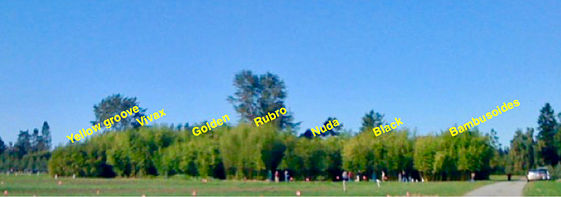
WSU grew 7 varieties of Phyllostachys. Vivax & rubromarginata grew tall quickly. Bambusoides is shorter because it is slower to mature. Groves were 7 years old when photo taken in 2009.
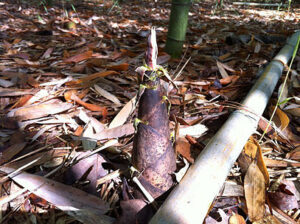
RESEARCH
My bambusoides research plot is set in the woods down-slope from the plots for Houzeau and moso. The soil there takes longer to warm up. In 2011, bambusoides began shooting on April 17 when the soil was 63°F. Houzeau began shooting April 11 at 72°F. Houzeau’s location has warmer soil. In 2015 bambusoides began shooting with 65°F soil on April 15 while Houzeau began the same day also at 65°F.
At my research farm in Hawkinsville, I planted the Bambusoides on high ground in full sun. I expect it to yield well. The first summer (2014), I mistakenly over irrigated such that water sat in one of the rows. That row died.
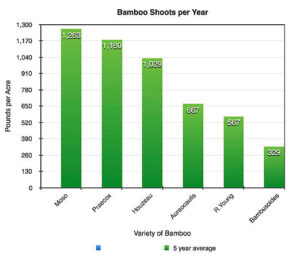
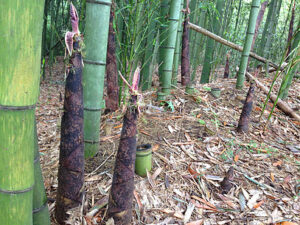
RESEARCH
The spring in 2013 was cold and late. Most bamboos of my research plots yielded less. Bambusoides was especially affected.
Shoot with green aural setae, colorful blades, dark brown
splotches. Culms green, straight.
Bambusoides pole on left; Slight nodal ridge. Moso pole on right; no nodal ridge.
Bambusoides cut in GA in 2000 at ABS annual meeting. (Pole photographed in 2017)
Phyllostachys bambusoides Tanakae growing in Fort Valley, Georgia. The spotted pole will be desired by bamboo crafters. I planted both the species bambusoides and its cultivar Tanakae at my research farm in Hawkinsville, Georgia, in April 2014.
Bambusoides is renowned for crafting.
Bambusoides is my latest shooter. This shoot is a good size for harvesting.
Bambusoides grows best outside my research plot on an abandoned pile of dirt. Soil warms early and is friable. I sometimes thin the hill slightly. Had I chosen this hill as my 1000 square foot plot, I would have better numbers.
Shoots can be shredded, eaten, and destroyed by squirrels. To save shoots that I do not harvest but leave to mature, I spray with Critter Ridder. The scent repells rodents.
